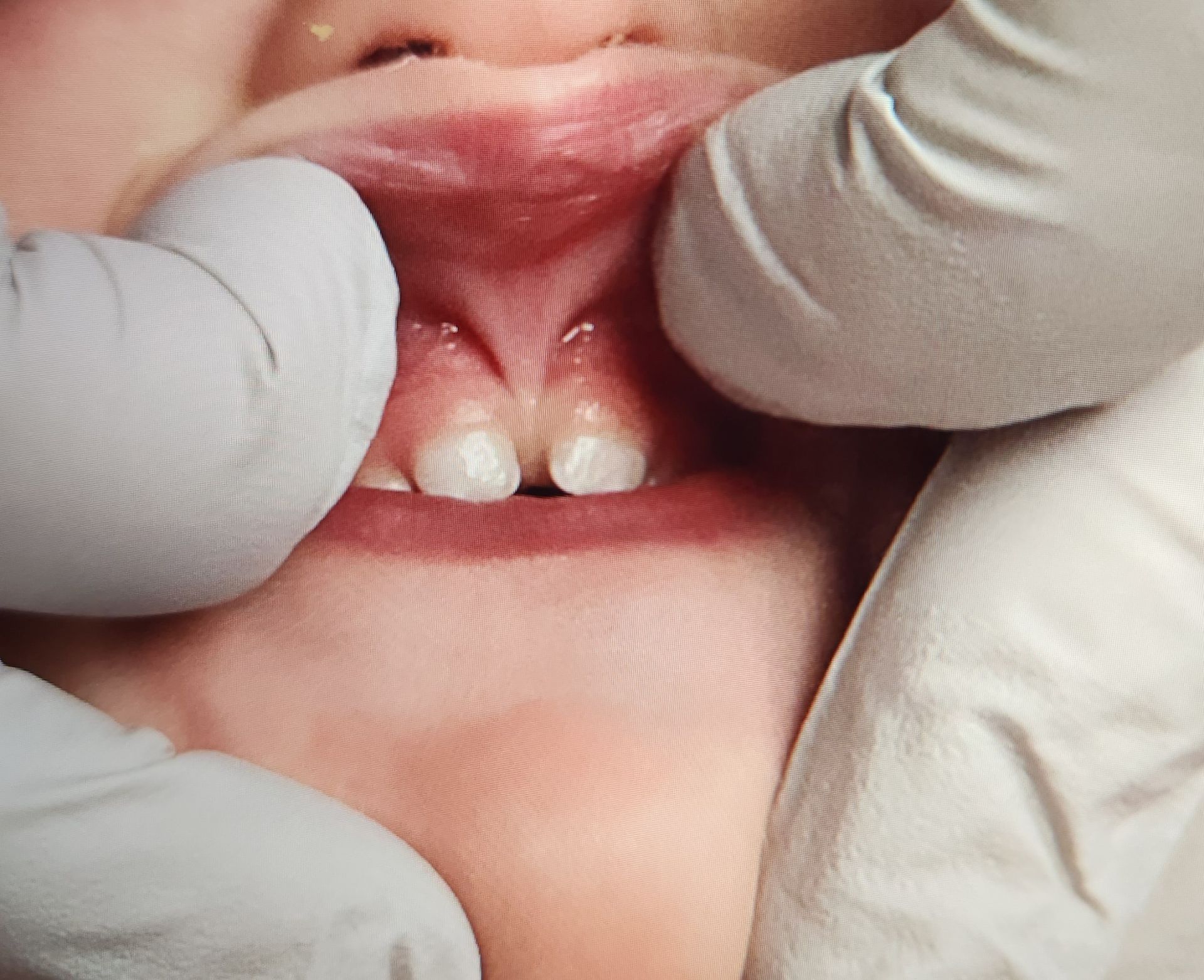Pediatric Pre & Post Tongue Tie Care
A tongue or lip tie in children is a congenital condition characterized by a shorter-than-normal lingual frenulum, the strip of skin beneath the tongue, or labial frenulum, the strip of skin connecting the upper lip to the gum. Unlike its initial impact on infants—such as breastfeeding challenges—a tongue or lip tie in older children can significantly affect speech development, dental health and airway concerns.
In pediatric cases, a restricted tongue may hinder proper speech articulation, making it difficult for the child to pronounce certain sounds or words clearly. This can lead to social anxiety or reduced self-confidence, complicating social interactions and academic performance. Similarly, a lip tie may contribute to speech issues and can also cause dental problems like gap teeth or difficulty in maintaining oral hygiene. In some instances, children with untreated tongue or lip ties might also struggle with proper food consumption, which can result in messy eating or digestive issues like bloating and flatulence.
Diagnosing a tongue or lip tie in children involves a straightforward physical examination by a primary care pediatrician, speech therapist, myofunctional therapist or pediatric dentist.
For speech issues, a speech therapist often conducts an assessment to identify any pronunciation or articulation challenges the child may be facing. This assessment complements the evaluation made by a pediatrician or a dental professional, who observes the tongue or lip's range of motion and considers any reported symptoms.
The grading scale for tongue and lip ties varies in its severity, impacting how much the frenulum limits natural movement. More severe cases usually warrant quicker intervention, especially if speech development is noticeably lagging or dental or airway issues are emerging or increasing.
Full and optimal treatment of tongue and lip tie often requires several weeks of functional exercises tailored to your child's needs by a myofunctional therapist for strengthening the tongue and 1-3 CranioSacral therapy visits to balance the child's body and oral tension prior to a quick surgical procedure called a frenectomy. This procedure, involves snipping the frenulum to allow for greater movement of the tongue or lip.
Following this process can result in improvements in speech, airway and dental health. After the release, speech therapy, myofunctional therapy and CranioSacral therapy will be recommended to fully address articulation issues, airway concerns and bolster the child's functional skills.
FAQ
-
What is a tongue tie?
A tongue tie occurs when the strip of skin under the tongue, known as the lingual frenulum, is shorter than usual, limiting tongue movement.
-
What is a lip tie?
A lip tie is a condition where the strip of skin connecting the upper lip to the upper gum restricts the lip's movement.
-
How does a tongue tie affect speech development?
One of the most immediate concerns for children with a tongue tie is its impact on speech development. A restricted tongue can make it difficult for a child to articulate certain sounds or syllables, which could lead to unclear speech or even speech delays. This can pose challenges in academic settings and can also affect a child's self-esteem and social interactions.
-
Can a tongue tie affect eating and swallowing?
Yes, children with a tongue tie may also experience difficulty with certain aspects of eating. A restricted tongue can limit the child's ability to move food around the mouth properly, potentially leading to messy eating, choking hazards, or digestive issues like bloating and gas.
-
Does a tongue tie have dental implications?
Absolutely. A tongue tie can interfere with a child's ability to maintain oral hygiene effectively. This could lead to an accumulation of plaque, higher incidence of cavities, or even contribute to the development of a gap between the front teeth.
-
How is a tongue tie diagnosed?
Diagnosis generally involves a physical examination by a healthcare provider. In children, the diagnosis may also involve evaluations from speech therapists or dental professionals who assess any related speech or dental issues.
-
How are tongue and lip ties treated?
They are typically treated through a minor surgical procedure called a frenectomy, which cuts the restrictive frenulum.
-
What are the treatment options for tongue ties?
Treatment typically involves a minor surgical procedure known as a frenectomy. This surgery snips the frenulum, allowing for a greater range of motion in the tongue. The procedure is often quick and can result in immediate improvements in the child's ability to speak, eat, and maintain oral hygiene. Depending on the severity of the speech issue, supplementary speech therapy may also be recommended.
-
Are there different grades of severity for tongue ties?
Yes, tongue ties are often graded on a scale that measures how much the frenulum restricts movement. More severe cases are likely to have a more significant impact on speech, eating, and dental health, often necessitating more urgent intervention.
-
What is the main difference between anterior and posterior tongue tie?
Anterior tongue tie occurs at the front of the tongue, visible as a thin piece of skin connecting the underside of the tongue to the floor of the mouth. Posterior tongue tie is located further back and is less visible, often requiring manual examination to be identified. It involves a thicker, less apparent band of tissue.
Please be advised that Family Seasons LLC is not a medical practice. The services, advice, and information provided here are not a substitute for professional medical care, diagnosis, and/or treatment. Family Seasons does not receive any form of compensation for our referrals. Always consult with a qualified healthcare provider regarding any medical conditions or concerns.






